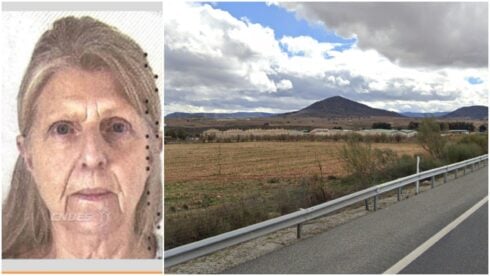 IT was one of the most shocking front pages in the Olive Press’ decade-long history reporting in Spain.
IT was one of the most shocking front pages in the Olive Press’ decade-long history reporting in Spain.
A dog lying prone on the ground after being shot in the head and a horse with its eye nearly poked out…the images were as graphic as they were shocking.
Part of a series of photos taken after the massacre of five rescue dogs on an expat’s land in Granada, we felt it was a story – and issue – that needed to be highlighted. In fact, shouted from the rooftops.
The British victim in question, Illona Mitchell, 48, fought back tears as she recalled how she had found her beloved animals strewn around her finca in the Sierra de Baza, on January 7, most of them shot in the head.
While police are now investigating, it is her theory behind the attacks that is, perhaps, of most interest.
For mother-of-one Mitchell, who ran a pony club on her land, had recently fallen out with hunters, who for years had rampaged across her estate, shooting pretty much anything that moved.
Indeed, Mitchell, who moved to Spain a decade ago, had decided that she didn’t want them hunting any more on her 173 hectares.
Insisting that she wanted to protect the last remaining deer and boars on her land, she put up signs and told the local hunting groups to stay out. Her local town hall ratified her decision and promised to honour her wishes.

And, of course, it went down like a lead balloon and she told the Olive Press how she had soon received insults in town and actually on her land. But nobody could have expected what came next; a cold-blooded execution of half her rescue dogs.
It is not however, the first time hunters in Spain have violently resisted the efforts of conservationists and animal rights groups.
In Asturias last year, measures to protect livestock from the Iberian wolf saw hunters decapitate two and leave their heads hanging from lamp posts.
Meanwhile, examples of the extremely rare lynx (the most endangered big cat in the world) have been found apparently shot or poisoned by landowners over the last decade, while the Olive Press investigated the shooting of rare eagles and vultures around the Serrania de Ronda area a few years back.
Even the extremely rare and endangered Iberian brown bears have from time to time been found shot in the north of Spain.
Environmentalists say the lack of a tradition of conservation in Spain means hunters are inclined to ‘shoot anything that moves’.
Their actions continue to clash with a rise in the animal rights movement particularly among Spain’s youth.

And the trend is encouraging.
In last year’s national elections PACMA, a political party based on animal rights, increased its votes from 220,000 to 285,000, a sign of the slowly shifting tide of opinion.
Some 94% of Spaniards now consider it ‘very important’ or ‘important’ to ensure the welfare of animals, up 23% from ten years ago.
Meanwhile the number of hunting licenses being granted is decreasing with more than one million failing to be renewed since 2006.
But while modern Spanish hunters receive a lot of stick, they say they get a bad reputation thanks to a lawless few.
They insist they respect the laws of the land, are equally into conservation, and claim the tradition gets them ‘closer to the deepest laws of the Earth.’
While the sport becomes less and less popular with the younger generation, it continues to be embedded in certain pockets of Spain, particularly in Andalucia.
Indeed, Spain’s largest region boasts more hunting opportunities than anywhere else in Europe with species to hunt including board, deer, ibex and partridge.

It is a profitable business with tens of thousands of foreigners flying in each year to take advantage of the rich diversity of game.
Among them are the British royals, in particular princes William and Harry, who have long been regular visitors to the estate of the Duke of Westminster, near Conquista, in Cordoba province.
On top of this, one of the largest hunting estates in Europe is owned by the Duke of Wellington, near Illora, in Granada province.
Hunting, of course, dates back to prehistoric times, when it was necessary for survival, but it became hugely popular during the Phoenician era – 1500 BC to 300 BC – when people enjoyed the ‘privilege’ of hunting freely and without restrictions.
By medieval times, hunting was the favourite pastime for the country’s elite.
While the military would hunt when on the road and locals would organise hunting parties for food and to protect their families from predators like wolves, the elite saw it as a fun distraction from running the country.
Kings would often retreat to their country houses to enjoy weekend shooting parties involving the tracking and killing of wild boar, deer and birds.

The 18th century King Carlos IV was known as ‘El Cazador’ – the Hunter – and was famed for his preference for hunting in Andalucia over dealing with affairs of the state.
Felipe V, the first Spanish Bourbon King, would often leave Madrid to spend quality
hunting time in the country.
But as numbers in the wild depleted, the elite began introducing measures and restrictions.
King Alfonso XIII became so concerned at the lack of Spanish Ibex that he created the first royal hunting area, or Coto Real, near Madrid, in 1903.
Ironically it was one of the first measures taken against the extinction of a species in the world.
Many restrictions have followed since but unfortunately too many have been ignored, leading to the extinction of species and the risks of many more around the country.
Today, Spain has 35 million hectares set aside for hunting in national parks, hunting reserves, national preserves and countless private game reserves.
Most animals are available, including wolves, while bears and lynx are officially protected.

But sadly this has not prevented deaths, leading to Ecologistas en Accion warning that Spain’s biodiversity is the most fragile in Europe… and last year thousands marched in Madrid to demand greater protection for the likes of the Iberian wolf, which can still be hunted with a special license.
While the majority of hunters enjoy their sport legally and respect the rules, it’s clear that the sport is set to come under increasing pressure over the next few years as younger generations become more politically aligned with environmentalism and animal rights.
And the massacre of half a dozen innocent rescue dogs in Granada does no favours to the cause. Hunting, like bullfighting, treads on eggshells.
Hunting hotspots
There are various categories of hunting land, ranging from free zones – where only a general licence (permiso de caza) is necessary – to municipal-owned reserves, private reserves (coto privado de caza) and national reserves, where a special licence is required.
To hunt in a national reserve you need a hunting permit issued by the regional office of the Ministry of Environment. Special permission is also required to hunt in a private reserve.
The most popular hunting regions are Galicia, the Pyrenees and in Andalucia, which boasts the Ibex, deer, wild boar and rabbit.

Fact file
The hunting season for game is from mid-October to early February. There are large fines for anyone caught hunting out of season
There are more than 900,000 licensed hunters in Spain
There are 35 million hectares of hunting land in Spain
More than 25,000 foreign hunters travel to Spain each year
The minimum age for hunting is 14, but hunters under 18 must be accompanied by adults
All hunters must pay a yearly license in each of the regions where they hunt
Click here to read more News from The Olive Press.









Wolf cubs were strangled in Los Picos de Europa Park by a member of SEPRONA about 10 years ago when the squad was investigating calf and goat killings. The squad came across a wolf den some meters within the Park. One of the squad members went into the park and strangled the cubs. It only came to light a few months later when his witnessing squad member, greatly disturbed by the illegal act, reported the killings to his superiors.
The guilty officer came from a local cattle herding family and did what cattlemen do – kill wolves and vultures any way they can – frequently with meat filled with poison or carpet tacks or glass. It took a huge amount of courage for the observing officer to turn in the guilty party. No doubt the social pressure was enormous.
The biologist charged with wolf protection was charged, along with SEPRONA officers for strangling and beating cubs to death in 2004. The case is reported here: http://www.animanaturalis.org/n/1404/biologo_del_parque_picos_de_europa_golpea_hasta_la_muerte_a_7_lobeznos
The issue comes in middle sized estates, not enough money for guards or fencing . Big hunting places like those of the Dukes make enough money out of hunting to protect themselves fron poachers.
And dont forget:
“Prince” Harry:
“Crackshot Harry, the buffalo killer: Picture emerges after prince’s call to protect wildlife”
“Prince Harry was among the 50-strong group who set out to hunt wild boar, deer and ‘just about anything you could point a gun at’”
“Former fox hunter exposes full scale of bloodsport’s barbarity as David Cameron seeks its return”
Pablo, please be aware that this newspaper and blog is about Spanish affairs. There are similar hunting-related acts all over the world, including the UK, and those cannot be condoned. However, this is an article about “the history of hunting in Spain” (please note the last word of the title). Turning an article specifically about Spain into an argument about the UK is a popular pastime of yours, isn’t it Pablo?
Pablo, how come you missed in your comment one of the biggest hunters “Crackshot King Carlos!”.